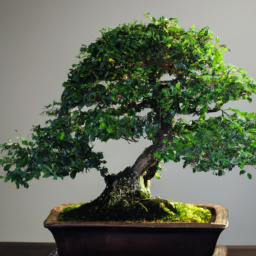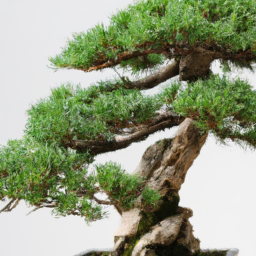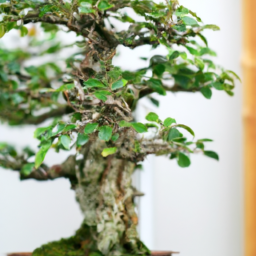
Are you looking to bring a touch of nature into your home with some indoor bonsai trees? If so, you’re in the right place! In this blog post, we’ll explore the different types of bonsai trees that thrive indoors. Whether you’re a seasoned bonsai enthusiast or a beginner looking to add some greenery to your living space, there’s a perfect indoor bonsai tree for you. Let’s dive in and discover the beauty and variety of types of bonsai trees that can flourish indoors.
Common Types of Bonsai Trees for Indoor Environments
Welcome to our guide on the common types of bonsai trees that thrive in indoor environments! Bonsai trees are a beautiful and unique addition to any home or office, providing a sense of tranquility and natural beauty. In this article, we will explore some of the most popular types of bonsai trees that are well-suited for indoor growing conditions.
1. Ficus Bonsai Trees
Ficus bonsai trees are a popular choice for indoor environments due to their adaptability and resilience. These trees have glossy green leaves and are known for their ability to thrive in a variety of light conditions. Ficus bonsai trees are relatively easy to care for, making them a great option for beginners.
When growing a ficus bonsai tree indoors, it is important to place it in a location that receives bright, indirect sunlight. These trees prefer consistent moisture, so be sure to water them regularly and avoid letting the soil dry out completely. Ficus bonsai trees can be pruned and shaped to create a variety of beautiful designs, making them a versatile choice for indoor bonsai enthusiasts.
In addition to their aesthetic appeal, ficus bonsai trees are also believed to bring good luck and positive energy to the home. With proper care and maintenance, these trees can thrive indoors for many years, providing a sense of peace and harmony to their surroundings.
2. Jade Bonsai Trees
Jade bonsai trees are another popular choice for indoor growing, thanks to their unique appearance and low-maintenance requirements. These trees have thick, fleshy leaves and a distinctive trunk that adds a touch of elegance to any indoor space. Jade bonsai trees are known for their resilience and ability to withstand drought conditions, making them a great choice for busy plant owners.
When caring for a jade bonsai tree indoors, it is important to provide it with bright, indirect sunlight and well-draining soil. These trees do not require frequent watering, so be sure to allow the soil to dry out between waterings to prevent root rot. Jade bonsai trees can be pruned and shaped to create a variety of artistic designs, making them a versatile and rewarding choice for indoor bonsai enthusiasts.
In addition to their beauty, jade bonsai trees are also believed to bring prosperity and good fortune to their owners. With their unique appearance and easy-care requirements, these trees are a popular choice for both experienced and novice bonsai growers looking to add a touch of nature to their indoor spaces.
3. Chinese Elm Bonsai Trees
Chinese elm bonsai trees are a classic choice for indoor growing, thanks to their graceful appearance and hardy nature. These trees have small, serrated leaves and a distinctive trunk that develops attractive fissures with age. Chinese elm bonsai trees are known for their ability to thrive in a variety of light conditions, making them a versatile choice for indoor environments.
When growing a Chinese elm bonsai tree indoors, it is important to provide it with bright, indirect sunlight and well-draining soil. These trees prefer consistent moisture, so be sure to water them regularly and avoid letting the soil dry out completely. Chinese elm bonsai trees can be pruned and shaped to create a variety of elegant designs, making them a popular choice for bonsai enthusiasts of all skill levels.
In addition to their aesthetic appeal, Chinese elm bonsai trees are also believed to bring balance and harmony to their surroundings. With proper care and maintenance, these trees can thrive indoors for many years, providing a sense of peace and tranquility to their owners.

Best Indoor Bonsai Tree Species for Beginners
Welcome to the wonderful world of bonsai trees! If you’re new to the art of bonsai and looking to start your own indoor bonsai collection, you’ve come to the right place. In this guide, I’ll introduce you to some of the best indoor bonsai tree species for beginners, along with tips on how to care for them and keep them thriving in your home.
Chinese Elm
The Chinese Elm (Ulmus parvifolia) is a popular choice for beginners due to its hardy nature and forgiving temperament. This tree is known for its small, glossy leaves and elegant, twisting branches. Chinese Elm bonsai trees are easy to care for and can thrive indoors with proper light and watering. They can tolerate a wide range of conditions, making them a great choice for beginners.
When caring for a Chinese Elm bonsai tree, make sure to place it in a bright location with indirect sunlight. Water the tree when the top inch of soil feels dry, and mist the leaves occasionally to increase humidity. Prune the tree regularly to maintain its shape and encourage new growth. With proper care, your Chinese Elm bonsai tree will reward you with beautiful foliage year-round.
In addition to their beauty, Chinese Elm bonsai trees are also believed to bring good luck and prosperity to their owners. So if you’re looking for a bonsai tree that not only looks great but also brings positive energy into your home, consider adding a Chinese Elm to your collection.
Ficus
Another great indoor bonsai tree species for beginners is the Ficus (Ficus benjamina). Ficus bonsai trees are known for their lush, green foliage and easy-going nature. These trees can adapt to a variety of light conditions, making them a versatile choice for indoor growing. Ficus bonsai trees are also relatively low-maintenance, making them perfect for beginners who are just starting out in the world of bonsai.
To care for a Ficus bonsai tree, place it in a location with bright, indirect sunlight. Water the tree when the top inch of soil feels dry, and mist the leaves regularly to increase humidity. Ficus bonsai trees are fast growers, so be prepared to prune them frequently to maintain their shape and size. With proper care, your Ficus bonsai tree will thrive and add a touch of greenery to your indoor space.
One of the great things about Ficus bonsai trees is that they are excellent air purifiers, helping to remove toxins from the air and improve indoor air quality. So not only will a Ficus bonsai tree enhance the beauty of your home, but it will also contribute to a healthier living environment for you and your family.
Juniper
For beginners looking to add a touch of Zen to their indoor space, a Juniper (Juniperus procumbens) bonsai tree is an excellent choice. Juniper bonsai trees are known for their rugged, gnarled trunks and delicate, needle-like foliage. These trees are easy to care for and can thrive indoors with the right conditions.
To care for a Juniper bonsai tree, place it in a bright location with plenty of sunlight. Water the tree when the top inch of soil feels dry, and mist the foliage regularly to increase humidity. Juniper bonsai trees are slow growers, so pruning is minimal. However, shaping the tree with wire can help create a more aesthetically pleasing appearance.
In addition to their beauty, Juniper bonsai trees are also symbolic of strength, resilience, and longevity. So if you’re looking for a bonsai tree that not only looks great but also carries a deeper meaning, consider adding a Juniper to your indoor bonsai collection.

How to Care for Different Types of Bonsai Trees Indoors
Welcome to our guide on caring for different types of bonsai trees indoors! Bonsai trees are a beautiful and unique addition to any indoor space, but they require specific care to thrive. In this article, we will discuss the different types of bonsai trees that are well-suited for indoor environments and provide you with tips on how to care for them properly.
Types of Bonsai Trees for Indoors
When choosing a bonsai tree for indoor cultivation, it is important to select a species that can thrive in a controlled environment with limited sunlight and humidity. Some of the most popular types of bonsai trees for indoors include:
1. Ficus Bonsai: Ficus bonsai trees are known for their vibrant green leaves and easy maintenance. They are well-suited for indoor environments as they can tolerate low light conditions and dry air.
2. Jade Bonsai: Jade bonsai trees are characterized by their thick, fleshy leaves and sturdy trunks. They are a popular choice for indoor bonsai enthusiasts due to their resilience and ability to thrive in low light.
3. Chinese Elm Bonsai: Chinese elm bonsai trees are prized for their elegant, serrated leaves and graceful branches. They are well-suited for indoor cultivation as they can adapt to a variety of light conditions and are relatively low-maintenance.
Tips for Caring for Indoor Bonsai Trees
1. Light: Place your bonsai tree near a window where it can receive indirect sunlight for at least 6-8 hours a day. Rotate the tree regularly to ensure even growth.
2. Watering: Bonsai trees should be watered when the top layer of soil feels dry to the touch. Use a watering can with a fine nozzle to avoid disturbing the soil and roots.
3. Humidity: Indoor environments can be dry, especially during the winter months. To increase humidity around your bonsai tree, place a humidity tray filled with water and pebbles beneath the pot.
4. Pruning: Regular pruning is essential for maintaining the shape and health of your bonsai tree. Use sharp, clean pruning shears to trim back overgrown branches and foliage.
5. Fertilizing: Feed your bonsai tree with a balanced liquid fertilizer every 2-4 weeks during the growing season. Be sure to follow the manufacturer’s instructions for dilution and application.
6. Repotting: Bonsai trees should be repotted every 2-3 years to refresh the soil and prevent root bound. Choose a well-draining bonsai soil mix and prune the roots as needed during repotting.
By following these tips and selecting the right type of bonsai tree for your indoor space, you can enjoy the beauty and tranquility of these miniature masterpieces for years to come. Happy bonsai growing!
Here are the Essential Points
Bonsai trees are a popular choice for indoor plants due to their small size and unique appearance. There are several types of bonsai trees that are well-suited for indoor environments, each with its own characteristics and care requirements.
Some popular types of indoor bonsai trees include the Ficus, Jade, and Chinese Elm. Ficus bonsai trees are known for their glossy leaves and ability to thrive in low light conditions, making them a great choice for beginners. Jade bonsai trees have thick, fleshy leaves and are known for their resilience and longevity. Chinese Elm bonsai trees have small, serrated leaves and are prized for their elegant, windswept appearance. With the right care and attention, these indoor bonsai trees can bring a touch of nature and tranquility to any indoor space.
Here are some FAQs you’d be interested in:
Q1: What are some popular types of indoor bonsai trees?
A1: Some popular types of indoor bonsai trees include Ficus, Jade, Chinese Elm, and Juniper.
Q2: How do I care for indoor bonsai trees?
A2: Indoor bonsai trees require adequate sunlight, regular watering, and occasional pruning to maintain their health and shape.
Q3: Can I keep my indoor bonsai tree outside during the summer?
A3: Yes, you can move your indoor bonsai tree outside during the summer months to give it access to more sunlight and fresh air.
Q4: Are indoor bonsai trees suitable for beginners?
A4: Yes, indoor bonsai trees can be suitable for beginners as long as they are willing to learn about the specific care requirements of each type of tree.
Q5: How long do indoor bonsai trees typically live?
A5: With proper care, indoor bonsai trees can live for many years, with some species living for several decades.
Dr. Olivia Green is a botanist with over two decades of experience in indoor plant cultivation. She holds a Ph.D. in Plant Biology and has dedicated her career to researching plant behavior in controlled environments. Dr. Green is passionate about helping plant enthusiasts master the art of indoor gardening through her extensive knowledge and practical insights.


